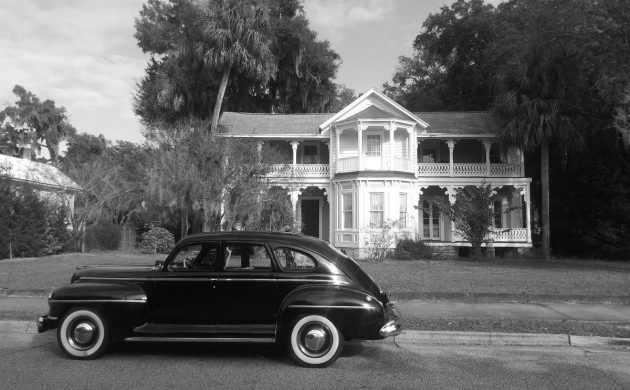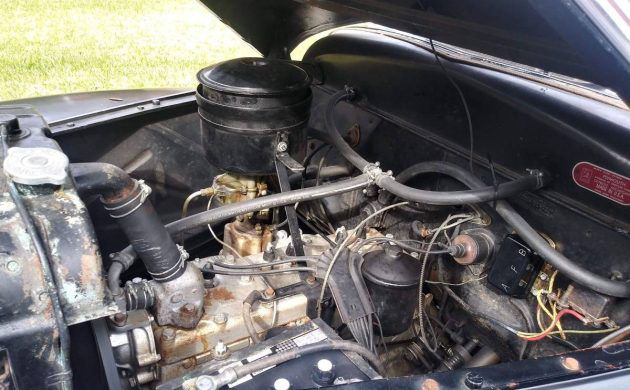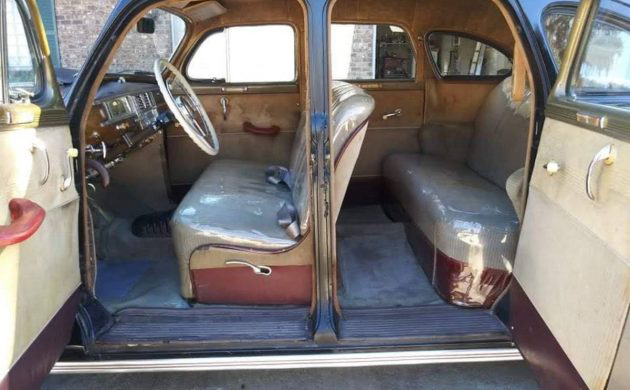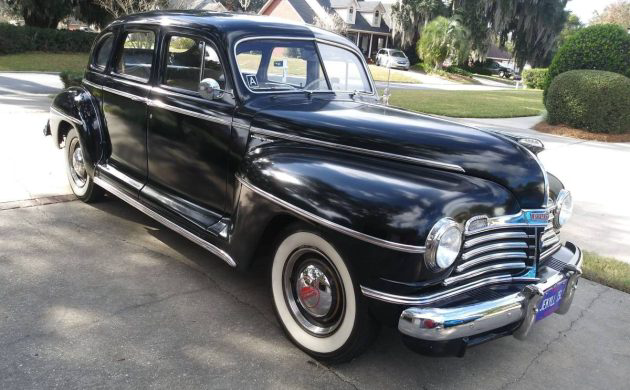
By 1942, most United States manufacturers had converted operations to wartime production. Ford made bombers. Alcoa made airplanes. Not even Lionel, the toy train company, was unaffected: it made compasses for warships. In 1941, Plymouth had just introduced its Finest! – the DeLuxe and Special DeLuxe passenger cars – only to be shut down by January 1942. Here on craigslist is one of the last cars produced before the war changed everything, a 1942 Plymouth Special Deluxe four-door sedan with an asking price of $20,000. The car has been garage-kept since new, has never been restored, and purportedly drives “like it’s 8 and not 80”. Bring it home from Brunswick, Georgia. T.J. sent along this great tip – thanks T.J.!

Plymouth’s Special Deluxe arrived in seven body styles, all sharing a 117″ wheelbase. The engine is a 217.8 cu. in. inline six-cylinder, making about 95 hp. Notably, aluminum was rationed due to the war effort, so pistons were cast iron. The transmission is a three-speed manual with R10 overdrive. Plymouth made much of its “oil bath” air cleaner and “Floating Power” engine mounts (rubber) – these innovations were touted as longevity enhancers – important during wartime when resources became scarce.

The broadcloth seats still wear plastic protectors and other than mild staining here and there, the interior is in great condition. The dash shows off plenty of stainless trim, gold accents, and a fine cluster of gauges. The seller notes that the car comes with its original owner’s manual, shop manual, parts catalog, spares, and dealer’s brochure. Speaking of dealer’s brochure, Plymouth promoted the spacious cabin and the car’s long, wide stance, positioning it against even luxury cars of the day. This comparison chart reminds buyers why Plymouth was the wise buy.

As the war dragged on, and even the most basic trim became scarce, plating stopped and castings were simply painted. This car was just early enough in the production line to receive shiny trim. The Special Deluxe flaunted stainless trim around its windshield, while the Deluxe made do with a painted surround. The grille had been redesigned in ’41 with heavier slats giving the car a more impressive “face”, and along the body, running boards were beginning to disappear. This modernized look would have to do for many years after the war ended: Plymouth’s first attempt at a redesign didn’t take place until 1950, and even then, the new car strongly resembled the old. Though the cars weren’t much different from year to year, Plymouth was a very popular make, selling hundreds of thousands of its Deluxe variants. Today, prices seem to hover in the mid-teens or even less. Here’s a handsome coupe for $12,500. Meanwhile, our subject car has been for sale for a much higher price here. What would you pay for this very original example?







Wow!!! Is it just me? Or are we seeing a lot more beautiful opening pictures on here. That 67 Caddy looked like it was out of a Cadillac brochure straight out of 1967. And this is just beautiful in black and white in front of that historic home.
That being said, this sure looks like a beautifully preserved Plymouth. It certainly looks like it was lovingly cared for over all these decades. I sure how this gets preserved for generations to come.
At first mid-coffee glance I thought this was going to be a PV544 or 444…but looks like a great buy at $20k.
A `42 anything is going to be scarce, and this Plymouth being mostly original is next to impossible to find. These cars had to survive for the duration of the war and in `42, nobody knew how long that would be. My Dad had a `40 Mercury coupe he said barely made it to `46 when production resumed! Locally in my city a blue `42 sedan (restored) is seen during car show season, but that’s about it. Steam-clean the door panels and call it good! A rare car anyone can appreciate!
This car was just written up here in December. A car so nice they had to feature it twice?
The story of the “blackout” 1942 cars, as they were often called, is much more than a materials shortage. Stainless steel and the raw materials involved in chrome plating were designated as strategic materials, and supplies were diverted for war production. As of January, 1942, auto manufacturers were barred from manufacturing most chrome-plated or stainless steel parts (bumpers being a notable exception), instead painting the trim. Even automakers with bright trim on hand were forced to paint it to prevent an unfair advantage.
One uncle had a ’41, another a ’48, I rode in both in the late 40’s. I think the ’41 was the cheap model, the ’48, the Special Deluxe. Compared to another uncle’s ’40 Ford DeLuxe, and an aunt’s ’38 Chevy Master DeLuxe, the ’48 Plymouth was hands down superior in fit, finish, and comfort. Probably due to Chrysler having to use basically the same body and other components on its more expensive models. You could not tell the engine was running at idle without looking at the amp meter. In overdrive it would do 60 all day, if the tires would. The Ford V8 was faster off the line, the ’38 Chevy less so.
I love everything — except those SEAT BELTS!!! Could they be removed without leaving a sign of their having been installed? A few things on the write-up. Plymouth underwent a major re-style in 1940 (as did the highly similar DeSoto). A face-lift in 1941 put a rounded heart-shaped frame around the grille, but mostly otherwise looked like the 1940. The ’41 was one rugged beast — still seen commonly on the roads in daily use in 1970s. The 1942 was either a drastic face-lift of the 1941, or else a complete re-style. The running-boards vanished fully under the doors, and the car sat lower. Wheel-openings changed in shape, and the grille was a totally different concept on the ’42. The tail-lights changed also, but remained in close to thd same positions. 1946 saw a significant post-war face-lift, with any hints of “art-deco” now gone. The grille was redone to look wider, and the headlights (at least looked) a bit farther apart on the ’46. The tail-lights were slightly modified to look taller and brighter. One interesting thing about these cars: that red Plymouth piece in the middle of the trunk-lid lit-up brighly when the brakes were hit — more than 40 years before an auxilliary brake-light would be made mandatory as a safety feature. These Chrysler cars WERE INDEED WELL-BUILT! Doors opened firmly and solidly, and closed securely. Body-panels lined-up truer, and leaks were rare. They also were well-insulated and quiet. But did this car have CARPETS as we see here? — I seem to recollect moulded rubber mats. The carpet and the seat-belt cause me to question this one. Why can’t new owners let surviving classics alone as originals? The price is a bit steep for a sedan of this vintage nowadays — however, that said, were it entirely an utterly unmolested original with no added carpet or seat-belts, I’d be tempted…
That red Plymouth piece in the middle of the trunk you refer to as a “third brake light” was the ONLY brake light on the car! They rear red side lights were only for running lights, and if you had the optional turn signal mechanism inside in your column, for turn signals. I know, as I own a 1948 Plymouth Special Deluxe coupe. I had to mount an additional brake light bar in the rear window for vehicles behind me to see that I was applying my brakes.
Walt, you are correct. Back then cars had two rear red running lights and one brake light in the center of the trunklid.
I remember as a kid, probably around 4 or 5 years old being fascinated by that brake light on the Plymouths. Not only was it glass, there was an imprint of a ship, one of Columbus’ I assume.
Chrysler had a long two inch high single brake light on the trunklid. I don’t ever remember seeing a Doge of that era.
I love everything — except those SEAT BELTS!!! Could they be removed without leaving a sign of their having been installed? A few things on the write-up. Plymouth underwent a major re-style in 1940 (as did the highly similar DeSoto). A face-lift in 1941 put a rounded heart-shaped frame around the grille, but mostly otherwise looked like the 1940. The ’41 was one rugged beast — still seen commonly on the roads in daily use in the 1970s. The 1942 was either a drastic face-lift of the 1941, or else a complete re-style. The running-boards vanished fully under the doors, and the car sat lower. Wheel-openings changed in shape, and the grille was a totally different concept on the ’42. The tail-lights changed also, from vertical to horizontal, but remained in close to the same positions. 1946 saw a significant post-war face-lift, with any hints of “art-deco” now gone. The grille was redone to look wider, and the headlights (at least looked) a bit farther apart on the ’46. The tail-lights were slightly modified to look taller and brighter. One interesting thing about these cars: that red Plymouth piece in the middle of the trunk-lid lit-up brighly when the brakes were hit — more than 40 years before an auxilliary brake-light would be made mandatory as a safety feature. These Chrysler cars WERE INDEED WELL-BUILT! Doors opened firmly and solidly, and closed securely. Body-panels lined-up truer, and leaks were rare. They also were well-insulated and quiet. But did this car have CARPETS as we see here? — I seem to recollect moulded rubber mats. The carpet and the seat-belts cause me to question this one. Why can’t new owners let surviving classics alone as originals? The price is a bit steep for a sedan of this vintage nowadays — however, that said, were it entirely an utterly unmolested original with no added carpet or seat-belts, I’d be tempted…
Now that’s what I call rear seat leg room, not like the crap we have today where your knees practically touch your chin.
And I love and want that house! OMG!
Spectacular find! Harrison Reid: thanks for posting twice, otherwise I may have missed your comment about an aversion to seatbelts. Really?
At a quick first glance I also thought it was a Volvo. Perhaps always believing that they looked like old Ford’s was wrong and they actually more closely resemble these.
Great car, nice to not see any restomodding comments. They’re only original once, leave them that way.
I agree on originality, Eric B.! Bunky, that is precisely my problem, here: why did they install seat belts (that don’t even match!), and that strange carpeting? And, could those things be UN-installed, without leaving scars? Every “low priced three” vehicle in this era had moulded rubber mats, made to fit, usually with the make of the vehicle moulded-in somewhere; likewise, on the floor of the trunk. I know, in the case of Ford, dealing with the Master Cylinder access under the mat often eventually caused the dried-out old rubber to split and crack. The front mats had small rectangular carpet inserts to guard from your heels wearing through the mat. They made reproductions of these mats, but the carpet inserts were chinsy and unworthy, cheaply glued-on — not hearty and moulded into the rubber like the originals. At least this was true 30 years ago; perhaps they’ve improved them since?? I was hit, head-on, by a 1978 L.T.D. doing 91-miles-per-hour (according to the police) just before Thanksgiving in 1994. I walked away unhurt, but that was the terrible end of my 1946 Super Deluxe Ford Tudor sedan. My passenger slammed into the dashboard, bending it, and he was bruised-up, but nothing broken. That car “died”, keeping us alive. It had been my “daily driver” for 27 years, and I still miss it.
Wait. Your comments seem to suggest that you’re against retrofitting seat belts into cars that originally didn’t have them (?). So, did your 46 have them? If not, how are you alive, let alone not even injured? 90 mph, head on? Your passenger would’ve had their skull fractured or other facial bones broken at least. That is terrible to hear, both regarding the car and any injuries, but I don’t understand a lot of this…..
You are free to not wear the seatbelt or remove it. I can’t, understand your desire to make yourself less safe but you certainly have that option.
My 1946 Ford had NO SEAT BELTS. It probably helped that I had seen the car swerve into my lane, and had slammed-on the brakes and might have been moving at about 10 M.P.H. when he hit me. He was wearing seat-belts in his 1978, but he wasn’t so fortunate. He was not killed, but the accident left him in critical condition with head and internal injuries, and they had to cut his car apart to extract him. The doors on my ’46 still would open — though the passenger’s side would do so only part-way, then we could not close it completely again. The passenger area of my 1946 was not crushed — though the entire nose of the car was destroyed. It looked as though I had slammed into a bridge-support at highway speed. That said, both my passenger and I were extremely lucky to walk away from it, and I credit that to the structure of the car. Another thing: lap-belts might hold you into your seat, but they do not protect your head — because your body simply hinges forward with great force, from the waist-up. In order for seat-belts to save you, you need shoulder-restraint also. And even then, the blow could cause your head to snap foward severely enough to break your neck (which is one reason why they came up with air-bags). With no seat-belts, your ENTIRE BODY moves forward when you are hit from in front — not just your head — and that tends to “share” the blow. The skid-marks from my car went back about 20-30 feet from the point of impact, and my car was still upright and sitting on the road, with its nose entirely crushed and both front tyres flat. Motor oil, anti-freeze, and battery-acid, all were leaking-out onto the pavement. His car went airborne upon impact, and ended- up partway up a tree, far more severely damaged than mine. And his passenger-compartment was crushed in front, whereas mine wasn’t. Maybe another time, another accident, hit by a truck, We might have been killed. But I also drove that car for 27 years, without so much as a dent or a scrape (a few stone-dings, that’s it). Considering how a classic car of that vintage ordinarily is driven, and how it reacts in an accident, I would have no fear about driving one without a seat-belt, and I would prefer that they not be added if they were not there to begin with — especially since lap-belts do little good and can actually CAUSE head-injury. Newer cars have head-rests extending above the front seats and behind your head. These help to subdue injury in the event of being slammed from the rear. Before they did that, “whiplash” and broken necks were quite common in rear-end crashes. But I am not going to add head-rests or air-bags or shoulder-straps to an antique car — any more than I would convert to sealed beam head lamps in a pre-1940 vehicle. And I would never convert the radio to AM/FM/Bluetooth (whatever that is)/stereo, and all the rest of it. If the antique has a radio, I would restore it and be content with AM reception only. An antique car is not for modernity in accessories; it is a trip back into when motoring was. They since have flattened it; but we had a road that was ruler-straight, but had three sudden rises in it that kids called “the thrill-hills”, because, if you took them at high enough speed, your car would be briefly airborne on the downward side, and it would feel as though your stomach were up into your throat and you were breathless for a moment. I say, if you want that, get on a roller-coaster– don’t try this in a car! The speed-limit on that road was 40 M.P.H., but young fools would rip through there at about 110, to get the “experience”. If you took it east, there was a long stretch to slow-down, before you reached the T at the end. However, going west, it ended at a Y where you joined highway traffic. Kids didn’t try to going west for that reason. But that day, this young fool DID, and when he hit the Y, he lost control. There was nothing on his side of the highway, but he slid across into my lane at ridiculous speed. Had I not been there, he would have crashed at full force into the trees (that entire side of the road is woods). Incid Rd ntally, t h ere are no crossroads or driveways along the v at straight road which had the three “thrill-hills” — just woods on both sides.
Hi, people don’t know about cars that us old kids grew-up in! I had a 58′ Roadmaster 75 4dr that could have a party in the back and not bother the front! if your knees were hitting on something back there you must’ve been playing twister!!!
Growing up in 60’ and 70’s one of my friend’s grandfather who lived with them but was old and didn’t do much had one of these parked in the driveway it didn’t run but we used to love sitting in it and imagining all kinds of things from bank robbery to shooting up enemies. This grandfather had a machine gun that impressed us kids and my friend found a stash of money that was endless. He would take $60 a day minimum and take us swimming, the park, then pizza and we didn’t have to walk or ride our bikes lol We never knew what grandpa was into but his son followed in his footsteps in racketeering and eventually was arrested and house seized but got away with it all. Go figure
ClassicP: wild ride! My family earned lots of money ABOVE the table, but I was dis-owned. Not their fault — they never knew that I was Autistic — they thought I was simply “contrary” to “conformity”, which infuriated them. Since I was brilliant intellectually, it never would have occurred to them to look for or potentially believe a mental handicap — so my interpersonal gaps were inexcusable in a family for which social standing meant everything. They never lived to see my Autism diagnosis: I had to forgive them in absentia, and forgive myself for all of the mistakes I made before therapy helped me to understand how most people respond, what they expect, and why. I never would have figured that curriculum out on my own. As a child in the 1930s and ’40s, I would plead, “Why doesn’t anybody like me? — what am I doing wrong?” And the answer I would receive would be some version of, “If you don’t know, I can’t help you — because it’s obvious — any four-year-old could answer such a stupid question”; Or, “You are your own worst enemy” — which told me nothing I could latch onto and hope to correct. Unable to read facial expressions or body-language, I am relentlessly verbal as my only means of effective communication. I’ve had to learn to look people in the eye — which is extremely uncomfortable for me. Still, I am awkward at best. Had they had social-intelligence tests, I probably would have scored a 38, and now might reach 63 on a good day. But I get by — which I couldn’t before: I was hated wherever I went, for most of my life, without understanding why or how. I knew something was wrong, but others insisted that there was nothing wrong with me — I was simply trying to make life difficult … for everybody around me and in contact with me, as well as for myself. I mention this struggle, because the disability behind it is hidden: I look “perfectly normal” and so my lapses are unforgiveable; whereas, if I used a cane or a leg-brace because of having survived polio, everyone would understand. You do not demand that the man in a wheel-chair get up onto his feet and run across the ball-field — you know he can’t. But a mentally-handicapped person who does not slur his words or drool at the mouth or look vacant in the eyes, who appears intelligent, “has no actual problem”, in the estimation of those around him. He’s just a tactless and unfeeling JERK, who doesn’t care about anyone but himself. It doesn’t reach them, that he cannot process the very concept of tact, because he can’t distinguish it from lying — and since he himself does not understand rhe bature of his difficulty, he is unable to express the problem he is having (even though it absolutely GLARES to anyone around him). I mention all of this, because I now am so grateful that young Autistic children are identified and helped early to surmount the social obstacles which come with the neurological difference we Autists have. But I refer to this for another reason. Many older adults (such as I) have suffered similar lives of chilly rejection and hostility, without knowing why; regardless how nice, pleasant, or accommodating they tried to be, without success. If that’s you, you might want to look into finding out if you are “on the Spectrum” [of Autism]. If it’s too daunting to approach a mental-health professional for a diagnosis, then pick up and read one of Temple Grandin’s books on the subject (she is Autistic). And if, while you’re reading it, it also seems to begin reading you, then you are probably one of us — and answers await you through a diagnosis! You would not believe the personal liberation!